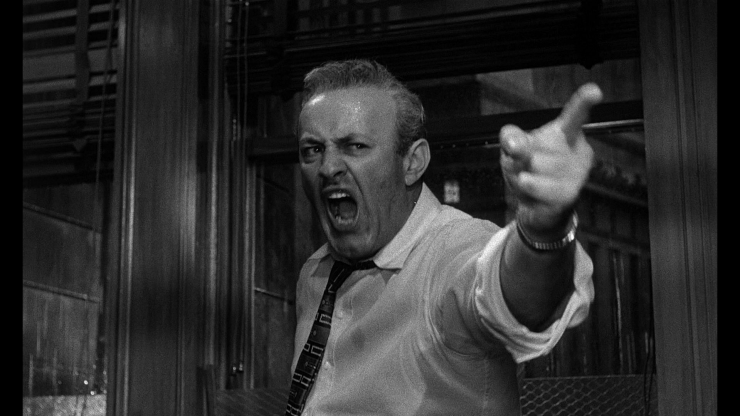
Cinematography is a powerful thing. In fact, sometimes it can even tell you which way a verdict is leaning in a murder case.
Sydney Lumet's 1957 drama 12 Angry Men stands as a real achievement in the art of cinematography. Lumet and DP Boris Kaufman managed to create a tension-filled nail-biter featuring twelve characters deliberating about a murder case all within a small courtroom due in part to the excellent camera work that pulled the viewer in and forced them to sit as the drama unfolded.
In this video essay, ScreenPrism explores this aspect of the film to reveal how camera angles and shot sizes were used to determine the emotional state of each juror as they begin to decide the fate of a young man accused of murder.
12 Angry Men takes place almost entirely in a small New York City courtroom, which means Lumet and Kaufman had far less to work with in terms of space compared to other filmmakers. They had to get creative with blocking and camera placement in order to make each shot mean something.
While the dialog and character blocking did the job of pushing the story along, the camera angles and shot sizes became pivotal for indicating the emotional states of each character as they slowly began to question not only their opinions on the case, but themselves as impartial jurors. As the video essay demonstrates, the angle of the camera and the size of the shot, whether it was high, low, or eye-level, wide, medium, or close-up, became an indicator of how each character felt about the case and the man accused.

Low angles typically give a character power while high angles typically take it away. Wide angles typically read as "removed" without much emotional intimacy, while close-ups typically read as "involved" with much emotional intimacy. Eye-level angles and medium shots typically give the impression of neutrality. But it starts to get much more complex and interesting as these kinds of shots combine.
The video essay states that high angles combined with wide shots give 12 Angry Men a certain objectivity, while low angles combined with close-ups ramp up the tension by evoking senses of pressure and claustrophobia. So, as you'll see in the film, the beginning of the twelve jurors' deliberation is mostly high/eye-level angles with wide/medium shots, but as tension mounts as more and more jurors begin to vote "not guilty", you'll see more low angles and close-ups.

Your Comment
1 Comment
This is interesting to watch. The angles change slowly within the scene as the power between them shifts.
Psychologist Scene from Jonathon Sendall on Vimeo.
September 20, 2016 at 7:42PM, Edited September 20, 7:42PM